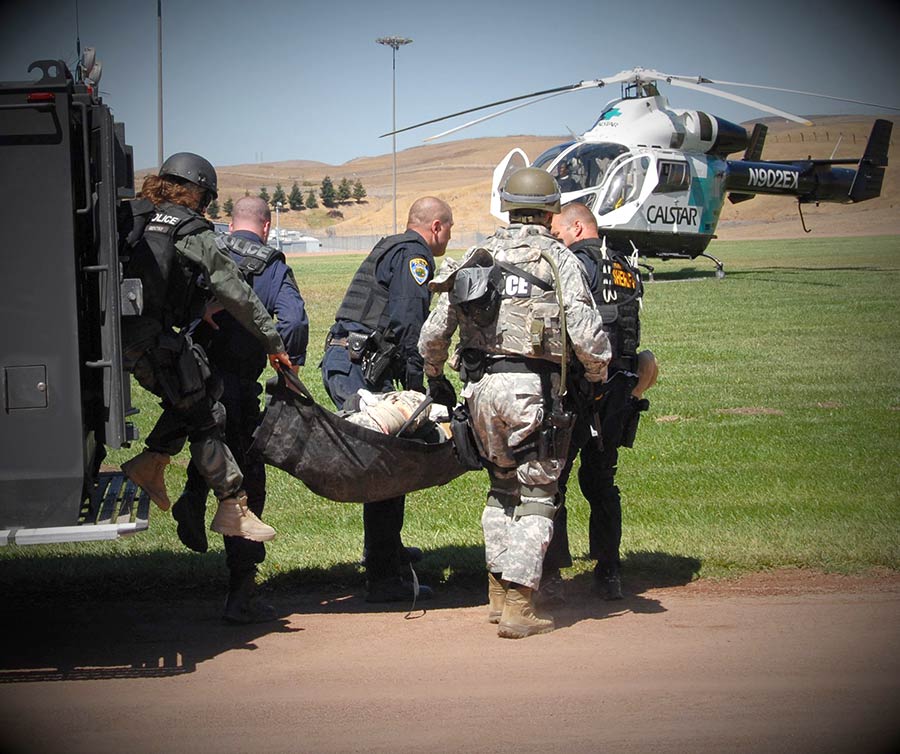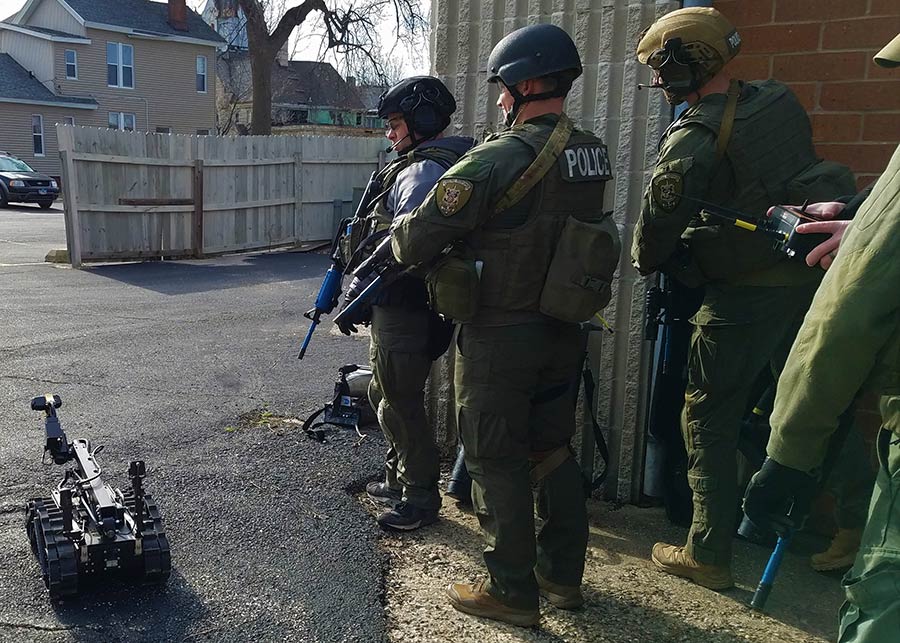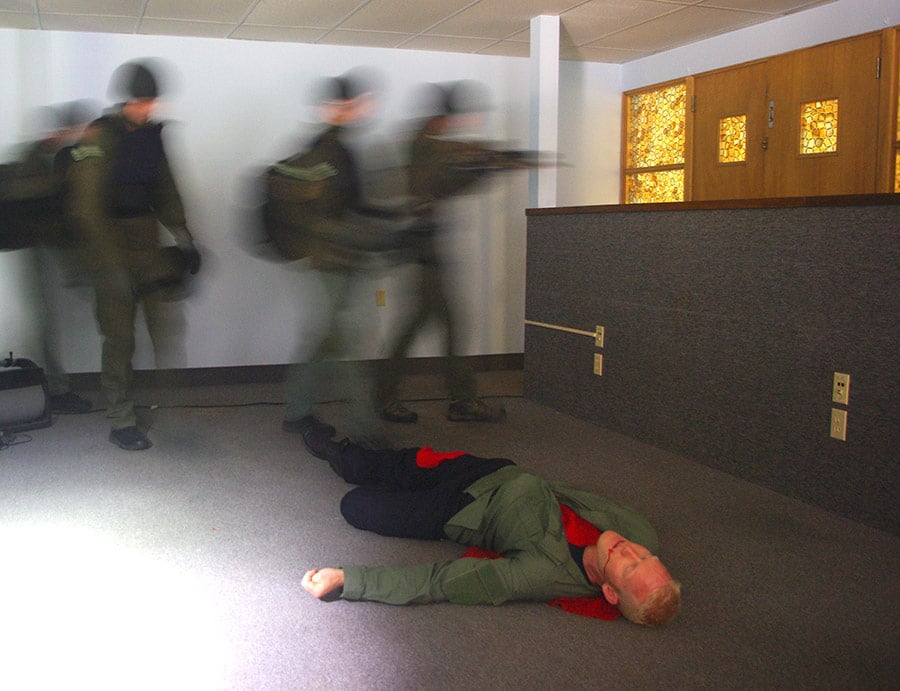What is Tactical Medicine?
Tactical Medicine, or Tactical Emergency Medicine, is the medical specialty that involves the services and emergency medical support necessary to preserve the safety, physical and mental health, and overall well-being of military and law enforcement (SWAT) special operations (tactical) personnel and others at the scene of critical incident deployments and training. Tactical Emergency Medical Support (TEMS) units are the working medical teams that deploy in training and real-world crisis situations, and a subdivision of the Tactical Medicine subspecialty. Tactical Medical Providers (TMPs) render medical care during training and at high-threat deployments where normal EMS and Fire personnel cannot safely respond. TMPs serve on a variety of teams including: special weapons and tactics (SWAT), federal law enforcement teams, military special operations units, government agency teams, and others. Tactical medical providers are professionals who ideally are trained to function effectively and safely deliver rapid high-quality emergency medical care in austere conditions, and also be competent in preventive medicine, team tactics and weapons safety and marksmanship, security, waterborne operations, environmental medicine, wilderness deployment, USAR (urban search and rescue), HazMat, extraction, CasEvac techniques, defensive tactics, and many other skills. The primary goal is to save officer/soldier lives. The secondary goal is to provide medical care for others at the scene and expedite extraction and transportation to augment the EMS system.
What are the goals of tactical and military special operations teams?
The primary team goal is to accomplish the mission with as few unintentional injuries and deaths as possible, with minimal or no property damage. The primary goal of TMPs is to safely help accomplish the team mission.
Medical goals of TMPs are to perform tactical medical duties effectively, competently, and as safely as practical, while helping those in need, and at the end of the mission, return home to loved ones. After a mission, TMPs should participate in team debriefing, analyze their response, learn from what happened, address any concerns, and prepare for the next deployment by improving tactics, procedures, and protocols. Continue to train with the entire team, and get better. Stay sharper. Improve teamwork. Save lives.
Defining Tactical Law Enforcement Operations: (NTOA)
The National Tactical Officers Association (NTOA) in their public-access website has the following 2018 SWAT Standards description.
The NTOA recognizes that there are many types of specialized tactical teams utilized in law enforcement and they are identified by a number of commonly accepted names.
The NTOA offers this set of team titles and corresponding metrics as guidance for its members.
Based upon the need to protect the public and ensure the safe delivery of tactical law enforcement services, the NTOA believes that a SWAT Tier 1 team must be mission capable in ALL of the following areas:
- Hostage rescue
- Barricaded gunman
- Sniper operations
- High-risk warrant service and high-risk apprehension
- High-risk security operations
- Terrorism response
- Special assignments
- Other incidents that exceed the capability and/or capacity of an agency’s first responders and/or investigative units.
The most resource-demanding of these missions is clearly planned deliberate hostage rescue operations. An appropriate number of personnel is necessary to rapidly and effectively dominate a structure and have an adequate number of operators in place.
SWAT and TEMS:
Law enforcement specialized tactical teams often deploy to high-risk, large-scale, and extended operations and under conditions that place hostages, bystanders, police officers, and suspects at increased risk for injury or illness. The risk profile calls for incorporating a medical element into all phases of these operations. In addition to rendering immediate medical care, properly trained medical providers assigned to law enforcement teams are able to assist commanders with developing pre-deployment medical risk assessment, implementing risk reduction strategies, providing logistic support, and serve as a liaison to coordinate medical operations with local emergency medical services (EMS).
What are the primary Roles and Duties of tactical medical providers (TMPs)?
These can be summarized in 3 key areas:
Before, During, and After a critical incident / SWAT / special ops team deployment.
BEFORE Team Deployment: TMP Roles
- Optimizing and maintaining tactical and medical team health through preventive medicine, sports medicine, and optimizing human performance.
- Education and training programs for all team members (including commanders, operators, and medics) in preventive and tactical casualty care.
- Provide experienced medical expertise in the forms of advice and input on decision-making, medical threat assessment, recommendations on internal policies as appropriate, provision of instruction in emergency medical care prior to deployment, and maintaining on-site medical response capability during all training activities.
DURING Mission Deployment: TMP Roles
- Provide emergency medical care, up close, ideally within 30 seconds.
- Provide consultation and preventive medical advice with team leaders.
- Organize and render immediate medical care, extraction, evacuation, and transportation of injured or ill officers or others at the scene who are in need of medical care
- Designate a TMP to accompany any ill or injured officers to the hospital, and remain a liaison with local EMS system personnel and leaders, local hospital staff, and involved prehospital agencies.
- Enhance communications and optimize medical care.
AFTER Mission Deployment: TMP Roles
- Remain available for medical questions and support, analyze and appropriately document the medical care provided, participate and remain involved in the tactical team debriefing, help with the evaluation of the team / SWAT operations/training and medical care, collect data, and make recommendations based on review and analysis.
- Learn from what happened, make improvements, and do it better next time. Don’t repeat mistakes. Participate in a national data collection system and assist with future research and improvements.
- Arrange a time to teach the entire medical and tactical team about medical ‘lessons learned’ and remain aware of any psychiatric difficulties faced by involved teammates. Know your team’s resources and how to mentally and physically support your team.
Who is involved in tactical medicine?
Medical practitioners of many different levels of training and fields can be involved in tactical medicine. First Responders, EMTs, AEMTs, paramedics, PAs, PHRNs, physicians… all are able to serve as active members of their TEMS units. The background of specialty training amongst medical providers can also be very diverse, including: emergency medicine, surgery, family medicine, orthopedics, OB/GYN, and others.
What are the advantages of tactical medicine?
Tactical medicine enables providers to bring expert and rapid prehospital care to those in need during realistic training, community crises, and high-threat military operations. There are increasing world-wide threats, increasing criminal and terrorist activity, more military-style weapons, and over 50,000 SWAT callouts per year in the USA. Some critical injuries that casualties suffer in a tactical situation require immediate response, and any delay of life-saving medical interventions may result in a preventable death. Deployment of SWAT and military special ops teams without TEMS / close-up medical support may result in unnecessary high risks, delayed medical care, and may possibly force inexperienced community EMS and firefighters to respond, who may be unfamiliar and untrained for the high threat tactical environment. If casualties have to wait for the scene to be “made safe”, then injured bystanders, LEOs, and others at the scene may have a worse outcome or death as a direct result. Tactical medicine providers can bring excellent medical care rapidly and more safely to those in need. The preservation of security and secrecy is enhanced with integrated TEMS, and liability and psychologic positive benefits are very important as well.
History of Tactical Medicine
Tactical Medicine and military special ops medicine continue to evolve. Since the first battle between humans, injuries and illness have been ever-present. Major progress in the history of medicine has often been made during wartime. Critical incidents in the civilian world led to the first SWAT (Special Weapons And Tactics) team formation by Chief Gates in 1965. His tactical teams from the beginning included embedded medical professionals (paramedics) for close-up medical support, in Los Angeles, California. Physician oversight since 1965 and TEMS (Tactical Emergency Medical Support) have continued to expand, although some tactical teams have unfortunately forgotten or strayed away from this concept. Tactical and military medicine and the battlefield settings they have been a part of, have been responsible for many medical developments and improvements over the course of time. Some examples of medical advancements that have developed include: the concept of hospitals and medical system (Roman Military), ambulance (French Revolution), triage system (American, French Revolutions, WW1), echelon hospital system and Medevac (WW 2, Vietnam), single-handed tourniquet application (Iraq/Afghanistan) to just name a few. More advances continue to this day.
More information under construction and coming soon on physician involvement.
Current status of Tactical Medicine in the USA
Tactical medical providers no longer take on just one role and have begun to participate with their tactical teams, LE Agencies, and military special ops teams in many different ways. There are over 50,000 SWAT deployments annually in the United States. A majority of tactical teams have integrated TEMS personnel. TMPs are now being expected to not only be able to provide immediate on-scene care, but also act as advisors and administrators for their tactical team as well. They are expected to be able to deal with a wide variety of preventive care issues, team health maintenance, environmental threats, and other threat assessments. Psychological support is a consideration, along with other key resources such as the simple basics of water, shelter, proper clothing, food, and toilet facility provision. This creates a unique challenge where tactical providers need to be well versed in tactical operations, providing competent medical care in a wide range of high-threat environments, and assist in the essentials of day-to-day team deployment requirements.
Current status of Tactical Medicine world-wide
It is unclear the exact extent of tactical medicine world-wide. Judging from the feedback and experiences, as well as increased publication and case reports from multiple countries, it does appear there is both increased presence of TEMS, and also increasing interest in the training of tactical medicine providers throughout many areas of the world. This is an opportunity for those interested, and further study and development will be helpful in many ways.
What are the inherent dangers of providing tactical medicine?
The good news is that nationally, there are very few injuries and deaths to TMPs. Fortunately, most LEOs and law enforcement agencies take many safeguards to protect the medical element/personnel. Although there are risks, a majority of SWAT deployments result in no one getting hurt or killed. The person who decides the outcome is usually the suspect/perpetrator of the incident. Significant threats to TMPs and other tactical team members do exist, however, and these are diverse and can be life-threatening. The below injuries and exposures are possible in a high-threat environment, and include, but is not limited to, the following:
- Gunshot wounds
- Stab wounds
- Explosions and Blast Trauma
- Animal bites
- Chemical exposure
- Biologic weapons exposure
- Radioactive contamination
- Environmental exposures
- Blunt trauma
- Illicit drug exposures
- Burns
- Musculoskeletal injuries
- Depression
- PTSD – post-traumatic stress disorder
- Concussion, and other Closed Head Injuries
- Infectious Disease Exposure, Blood Borne Pathogens
- Drownings and water-borne hazards
- Others
It is imperative that the tactical team and TEMS unit leaders search for and seriously address the significant threats that their tactical team and TEMS personnel are potentially exposed to. With good situational awareness and attention to detail, hopefully the team can properly prepare for, recognize, and neutralize these threats appropriately. Once the scene is sufficiently safe, and the risks to rewards have been briefly considered, then expedient life-saving tactical emergency casualty care should be provided by appropriate personnel who are trained, equipped, and have the skills and knowledge to intervene as a team effectively and safely.
Photo Gallery
Start the slideshow by clicking on any one of the images below.











